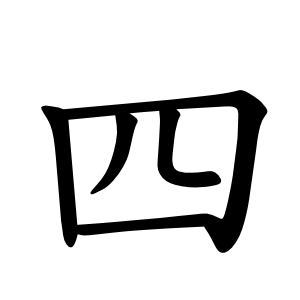四
- four, number 4, fourth;
Etymology
In oracle bone script, it was written as 亖. This form is an ideogram, created in the same way as 一 (1), 二 (2), and 三 (3). With two "二" stacked vertically, it can be interpreted as "two plus two makes four."
However, starting from the bronze inscriptions, the character 四 began to be borrowed and used instead. From the seal script period onward, 四 completely replaced 亖 in common use.
The original meaning of 四 was to depict breath coming out of the mouth, and its root form is considered to be 呬 (pronounced heui, meaning "to breathe"), which includes the radical 口 (mouth). Therefore, 四 eventually replaced 亖, and 呬 came to represent the original meaning.
Words that derived from 四
Additional notes
Interestingly, the characters 一, 二, 三, and 亖 also resemble the military ranks of soldiers in South Korea.
Because 四 (four) is a homophone of 死 (death)—both pronounced sǐ in Chinese—it came to be considered unlucky in East Asian cultures (China, Korea, Japan, and Vietnam).
In Japan, this superstition also affects pronunciation: the on'yomi (Sino-Japanese reading) シ (shi), which sounds like "death," is often avoided. Instead, native Japanese readings like ヨ (yo) or ヨン (yon) are used—similar to how Koreans might read numbers as “il, i, sam, net, o...” rather than using Sino-Korean readings alone.
However, this avoidance is mainly when counting numbers in order; in compound words, the on'yomi is still commonly used.
For example:
4월 (April) = 四月
사각 (square) = 四角
Alternative forms
亖 (used from the oracle script era),
肆 and 䦉 (more complex variants).
- 田金 (WC)
- ⿴ 囗 ⿰ 丿 ㇄ (G H T V)
- ⿴ 囗 儿 (J K)
